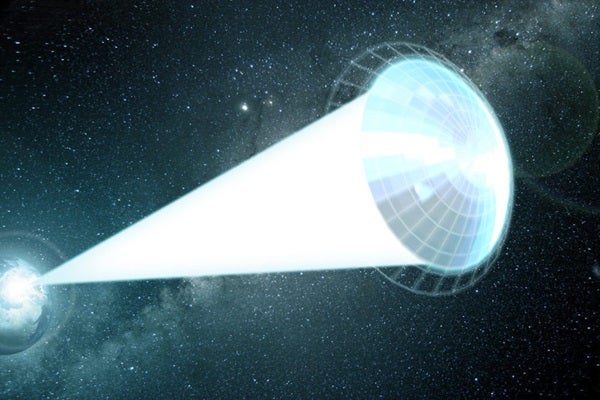Lightsails were once a thing of science fiction, evolving through several variations over the last 40 years. Now, science fiction is becoming reality. Advances in laser technology and new ultrastrong, ultralight materials open up the possibility of venturing beyond our solar system in the not-too-distant future.
Researchers from UCLA and the University of Pennsylvania recently published two papers outlining various shapes and heat-dissipating materials they tested to evaluate lightsails beyond previous limits. The research was conducted in conjunction with the Breakthrough Starshot Initiative, a project with the goal of sending a microchip-sized probe to the Alpha Centauri system, which, at just over 4 light-years away, is the closest and possibly most habitable neighboring star system. Breakthrough Starshot plans to use a high-powered laser array to propel tiny lightsail probes through space at a top speed of some 20 percent the speed of light. Incorporated into the sails would be minuscule scientific instruments, such as cameras, magnetometers, and communicators that could beam information back to Earth as they fly through the Alpha Centuari system.
A parachute that can withstand the heat
Aaswath Raman, a professor in the Department of Materials Science and Engineering at UCLA, has laid out two elements key to creating a functioning lightsail: it must be extremely lightweight, and it needs to reflect or disperse heat incredibly well.
Previously tested solar sails, which harness momentum from the Sun’s photons, only require reflective mylar or plastic with aluminum to survive. However, Raman’s research focuses on lightsails that would be propelled by laser beams many times more intense than the Sun’s rays, and reflective mylar or plastic lightsails would quickly disintegrate when blasted with such powerful lasers. Published in January, the research describes the secret ingredients that may help such lightsails disperse the copious heat that builds up when targeted by lasers: 2H-phase molybdenum disulfide, crystalline silicon nitride, and nanoscale patterning. The sail’s grid-like fabric, about the width of a human hair, is specially designed to withstand the heat by efficiently harvesting the laser light so it will be quickly accelerated, reducing the need for long-term exposure to the laser beam
Also integral to the research was Igor Bargatin, a professor in the Department of Mechanical Engineering and Applied Mechanics at the University of Pennsylvania. Bargatin was not only a co-author of Raman’s paper but also headed his own study, released this past December. In his work, he describes and calculates what shapes and overall mechanics are most fitting for a laser-propelled lightsail.
Bargartin found the lightsail must have curvature so it can billow out and avoid tearing. This curvature also must be significant, with the ideal lightsail being about as deep as it is wide. That would make such a lightsail more like an old-school parachute than a ship’s sail.
Another consideration was making the lightsail extremely thin, but not too thin. “It is going at a much faster speed than any other any other spacecraft so we had to consider that the light intensities would be significant, therefore extremely thin. We were finding that balance in the light pressure that would not tear in the acceleration phase,” Bargatin said. He is now testing out some of theories and creating prototypes, the findings of which should be published in the next year or so.
Deep Jariwala, a professor in the Department of Electrical and Systems Engineering at the University of Pennsylvania, is working with others to fabricate pieces for a prototype lightsail. But regardless of whether these researchers ever achieve the lofty mission set about by the Starshot Initiative, Bargatin and Raman believe their work could also have applications a lot closer to Earth.
“This particular project has an extreme set of constraints or demands because the goal is so aggressive. We can do it within the next couple of decades, but whatever we are learning about laser-based sails could also help us go to Neptune or Uranus, which was sort of thought to be out of reach for solar sails,” Raman said.
Progress with Breakthrough Starshot
The Starshot Initiative is still in the very early stages of development. But since the project got off the ground in 2016, Avi Loeb — chairman of Starshot’s advisory committee and professor of astronomy and cosmology at Harvard University — doesn’t think they’ve encountered any dealbreaker technological challenges, or what he likes to call “showstoppers.”
In fact, Loeb said the lightsail’s development has seen the most progress, while developing the communication aspects of the mission has been far more challenging. He explained that the transmission of information becomes much dimmer over light-year-scale distances, not to mention it would take a touch over four years for the signal to reach Earth.
More than $100 million has been allocated to the Breakthrough Starshot project for the next decade, or more, of research. However, Loeb believes the investigation could take at least another couple of decades, and possibly be one of the most expensive space endeavors we have ever seen.
But for him it’s a worthy investment. Not only will the technological advancements produced by the Breakthrough Starshot project ripple out through the real world here on Earth, Loeb believes knowing what is outside of our solar system is important for future generations.
“We want to see that we aren’t the smartest kids on the cosmic block,” Loeb said.










